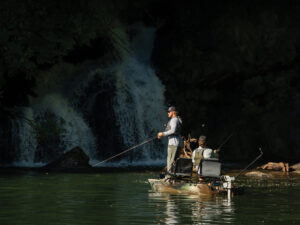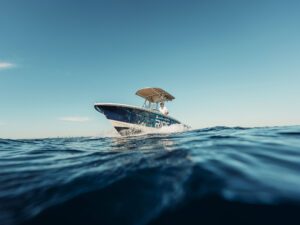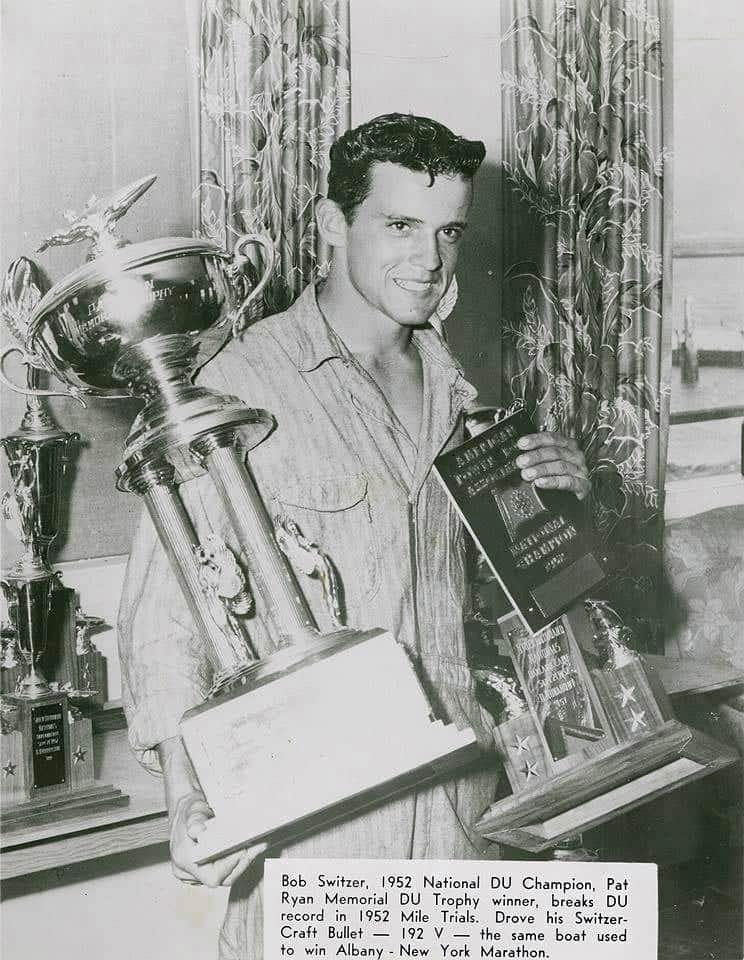
Bob Switzer, co-founder with his brother, Dave, of Switzer Craft Boat Company, died on December 29, 2017. He was 85 years old. Bob’s racing successes included three national outboard championships, a win in the Albany-to-New York marathon in 1952, and many more victories throughout his long racing career. Following World War II, Bob and Dave Switzer began building successful wooden racing hulls for stock outboard classes from a shop in Crystal Lake, Illinois, and later moved into production runabout and cruisers, many of which featured wild styling, including tail fins like those on autos of the era.
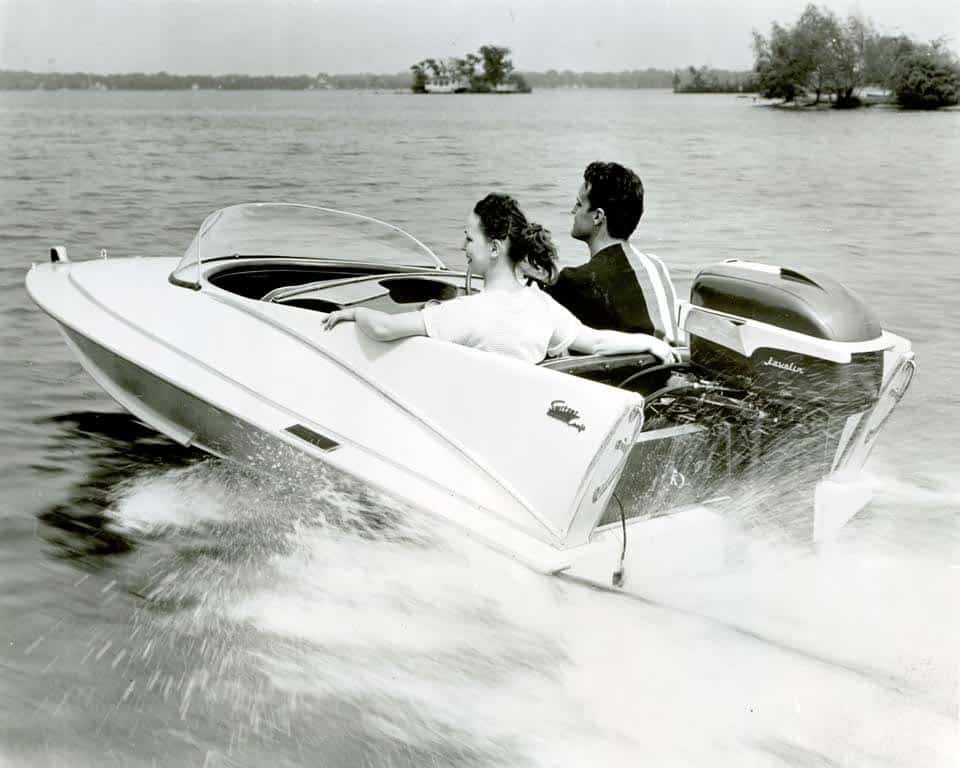
In the late 1950s, the Switzers — Dave handled most of the design work while the more outgoing Bob raced and handled promotion — began experimenting with aerodynamic designs that would employ lift to reduce drag. The 18-foot U4 Switzer Wing, or Hydro-Cat, debuted in 1961 and ran more than 80 mph with a pair of 80 hp outboards, and outran the Mercury factory race team. That led to the following story, as retold below by Bob Switzer (copied from OffshoreOnly.com, original publication date unknown).
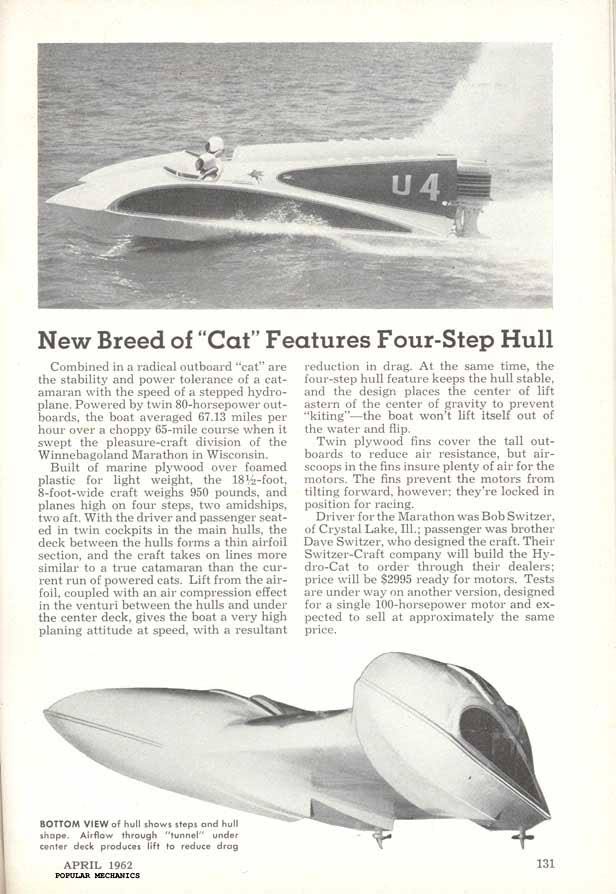
“The Day I Flew a Boat,” by Robert Switzer
It all began with a phone call (person to person) to me, Bob Switzer, from Carl Kiekhaefer, president of Mercury Marine. The date was July 17, 1962. The meat of the call was a request for Switzer Craft to build a boat for twin Mercury 100 hp outboards that would exceed 100 mph on water.
The call was impressive. Imagine … out of hundreds of boatbuilders, we were called to do this project. We immediately began designing our first effort based on the pattern of the Switzer Hydro-Cat (commonly referred to as the “Switzer Wing”). In 1961, the Switzer (U4) wing was a major breakthrough in the twin-engine Stock Outboard Pleasure Craft Class U (unlimited engines, but required to be a minimum of 15 feet in length). The first Switzer Wing was built in nine days, just prior to the Winnebago Outboard pleasurecraft event, where the Switzer Craft Wing finished first overall, and the next two classes were also won by other Switzer models. The U4 was the first cat to exceed 80 mph with only a pair of 76 cubic-inch, 80 hp outboards.
Our first new design developed to meet Mr. Kiekhaefer’s request was not a complete success. At speeds of over 85 mph, the bow had a tendency to kite or “bow up” (a feared maneuver of every driver).
In late August, we tried a new hull concept, mounting the engines midship in a hull much like the Hickman Sea Sled. It featured square simple lines and a shovel nose. We hoped that the engines forward could control any bow-lift tendencies. Much to our regret, the trial runs showed that the thrust of the propellers forward and under the hull clamped the back of the boat to the water, and drag was too much for our twin 80 hp Mercurys to overcome in the initial plane-off.
Time was slipping away, the leaves were turning into their fall colors, and we estimated approximately five weeks of open water to test on the Fox River near our plant. A decision had to be made: Do we call Mr. Kiekhaefer and postpone the project until spring, or do we keep going “right up to the wire” as the saying goes? The decision was made: Keep going!
My brother, Dave Switzer, was the designer in charge of the construction phase of this project. He knew that now the pressure was on to design and build that 100 mph boat in minimum time. Russell “Pop” Switzer, a pioneer in light aircraft and seaplanes since World War I, injected some new ideas he had long thought were necessary to control a boat at flying speeds. Dave welcomed these new ideas and also accepted a weight distribution change that I had recommended. We also concentrated on making a cleaner airflow version of his original U4. Several days later, the materials were flying into shape, and the U6 hull was finished in record time. With time running out fast, it was rigged for the first test runs.
We proceeded to the test area on November 29, 1962, only to find that there was one-quarter inch of ice on the river, stopping all progress. The weather reports promised warmer weather for the next day. All was held in readiness. November 30, temperature 45 degrees, sky clear, water open and calm. Time 10 a.m., we launched the U6. I got into the enclosed Plexiglas cockpit (much like the capsule boats of today), checked out all instruments, fired up engine No. 1, check, No. 2, check, water-pressure and cooling systems OK, tachometer reading steady, fuel pressure normal, close the aircraft-type canopy over the cockpit, bring the engines to warm-up speed, and taxi to position for a wide-open run.
Now, increasing speed to 50 mph, 60, 70, 80, and now at the speed range where the previous design started to kite, I used the foot throttle override and steering with my left hand, I put my right hand on “Pop” Switzer’s stabilizing control lever, which operated the elevon (wing tail flap) controlling the last 2 feet of the center section between the twin hulls. At 85 mph, the bow lifted slightly off the horizon — too high for safety. I pushed the lever forward to position 1 (of 4), and the horizon line returned to normal. Now, at 90 mph, a slight bow lift again, lever to position 2, now the bow was normal in good trim again. Suddenly, at this moment, many things seemed to occur. While my 17-inch pitch props (Record from Switzerland) were turning almost 6,000 rpm, my neck snapped back, the hull lifted off the water about 2 to 4 inches … no vibrations from water contact. I felt like I was in a seaplane just after liftoff from the water. The rpm suddenly dropped back to approximately 5,000, and at the same time, the speed increased to the shrill sound of the two engines harmonically balanced. I glanced down at the Keller calibrated speedometer, reading 96, 97, 98, 99, 100 with those 76 cubic-inch, 80 hp direct-reversing engines revving at nearly 7,000 rpm. I knew we had just what Mr. Kiekhaefer asked for. Now [I felt] almost tranquil from the experience of “The Day I Flew a Boat” with a full boundary layer of air between the hull and the water and seeing houses go by like a picket fence. I realized that the straight-away water was fast running out. So, deceleration of the U6 was started with the same caution used in increasing the speed. The stabilizer control was returned to various positions as the speed was reduced. When the boat speed was between 80 and 85, there was a loud sound and vibration from the hull re-entering the water, almost like driving from the highway to a washboard gravel country road. Taxiing to the launch site where all the Switzer Craft crew were on hand for the verdict, I could hear all the questions. How did it handle? How fast did it go? What was it like? And you know the answers.
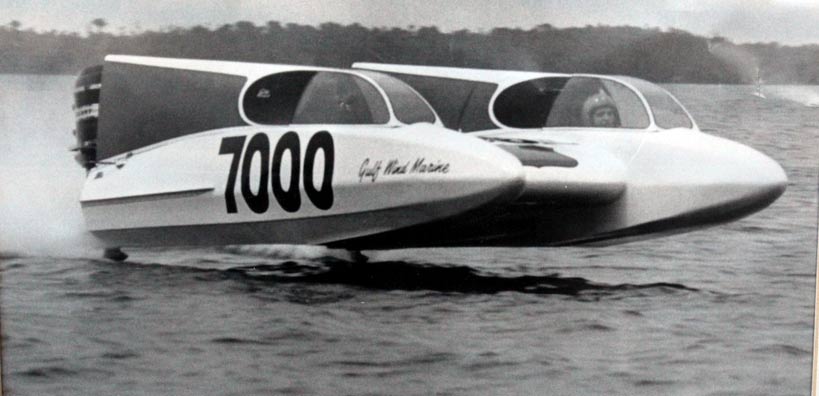
The hull was then returned to the factory for final preparations to be delivered to Mr. Kiekhaefer at Lake X, where she was fitted with a pair of 99 cubic-inch, 100 hp engines with stacks and double-pinion Speedmasters. She went on to reach speeds in excess of 120 mph. This same hull, driven by both Johnny Bakos and Dave Craig, startled many of the onlookers and the helicopter pilots that could not keep up with her to allow the photographers to film her as she won the Gold Coast Marathon from Miami to Palm Beach and returned on the inland coastal waters with a record average speed of 81.78 mph that may still stand today!

